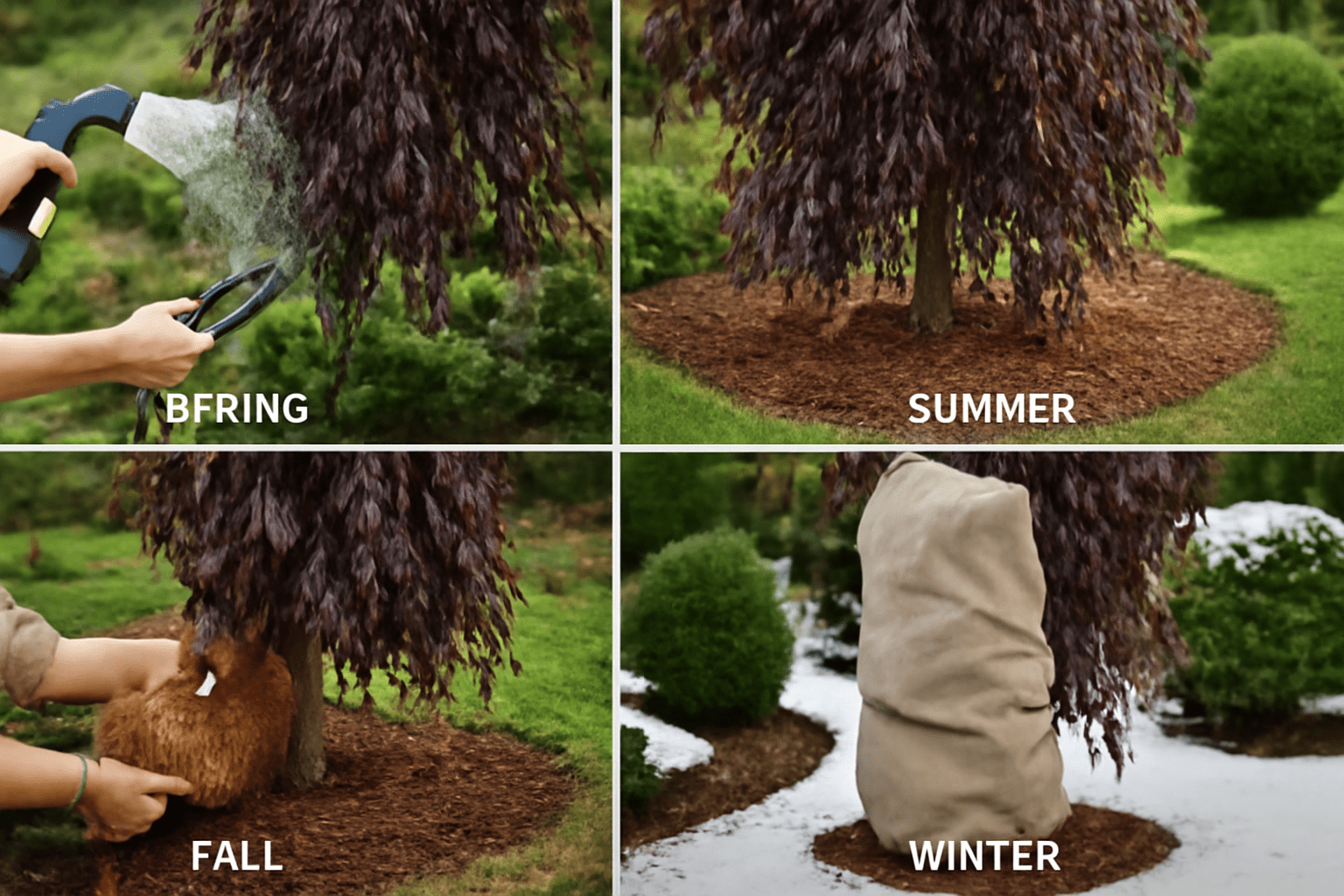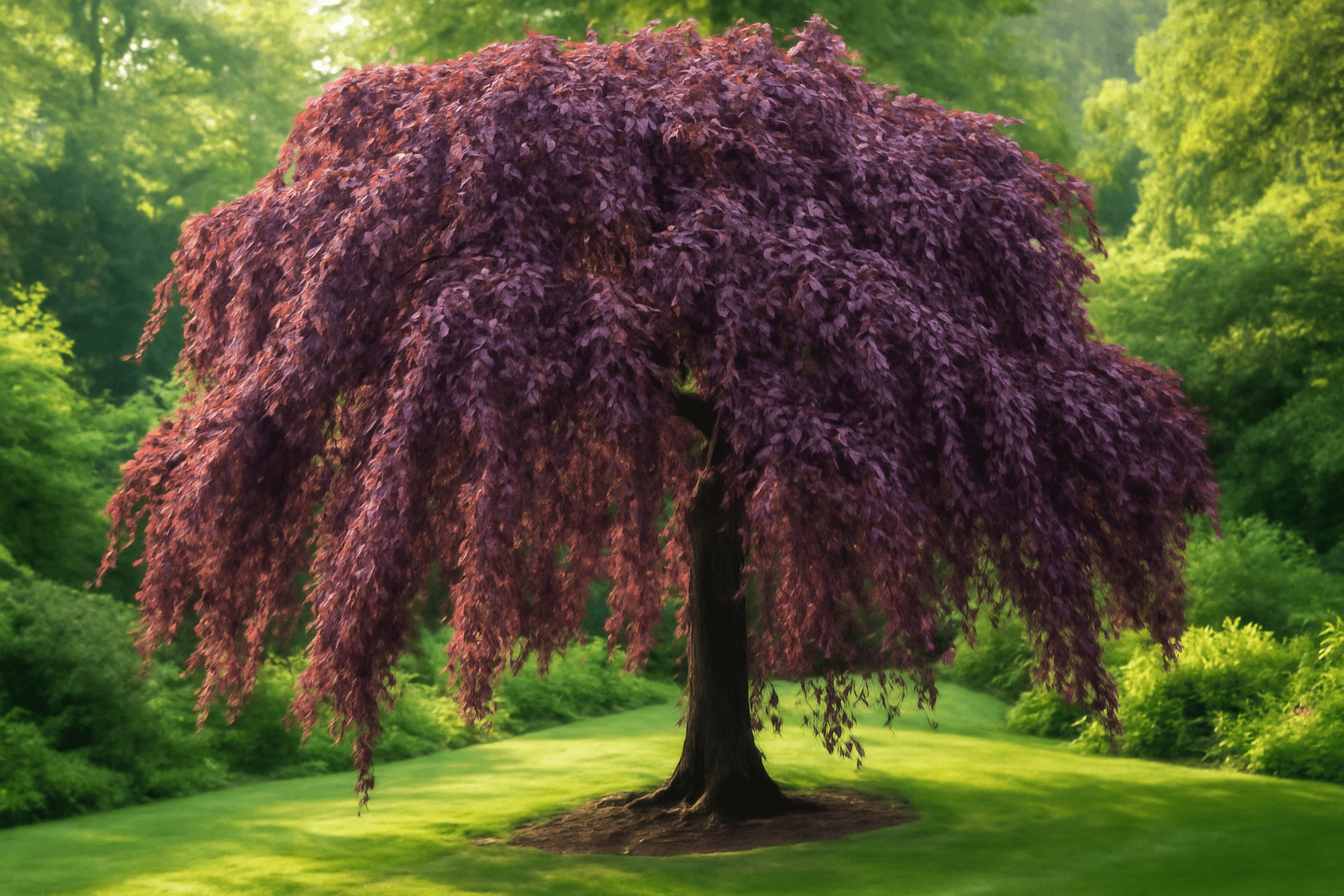
Purple Fountain Beech Tree: The Ultimate Guide to Growing, Pruning, and Caring for This Stunning Tree
Looking to add a striking feature to your garden that combines beauty with low maintenance? 
In this ultimate guide, we’ll cover everything you need to know about growing, pruning, and caring for your Purple Fountain Beech Tree. Whether you’re planting it for the first time or seeking tips to maintain its health and appearance, this guide will provide practical and actionable insights. Keep reading to learn how to ensure your Purple Fountain Beech Tree thrives year after year!
Table of Contents
ToggleWhat is the Purple Fountain Beech Tree? 
The Purple Fountain Beech Tree (Fagus sylvatica ‘Purple Fountain’) is a striking, ornamental tree that stands out in any landscape. Known for its dramatic, weeping branches and deep purple foliage, it adds a touch of elegance and color to gardens, parks, and yards.
This tree is a variety of the European Beech, but with a unique twist: its leaves emerge in a rich, reddish-purple color, which intensifies as the season progresses. As it matures, the branches droop downwards, creating a stunning cascading effect.
Not only is it visually appealing, but the Purple Fountain Beech is also quite adaptable. It thrives in a variety of soil types, making it a versatile choice for both seasoned gardeners and beginners alike. Its compact size makes it perfect for smaller yards or as a focal point in larger landscapes.
In terms of growth, the Purple Fountain Beech reaches a height of about 6 to 8 meters (20 to 26 feet), with a spread of around 4 to 6 meters (13 to 20 feet). Its slow growth rate means it won’t outgrow its space too quickly, giving you plenty of time to enjoy its beauty as it matures.

Key Benefits:
- Attractive Purple Foliage: The rich color brings year-round visual interest.
- Compact Size: Ideal for small spaces or as a focal tree in larger gardens.
- Low Maintenance: Once established, it’s relatively easy to care for, needing minimal pruning.
Whether you’re looking to add color to your garden or find a tree that provides shade without overwhelming the space, the Purple Fountain Beech Tree is a perfect choice!
Best Growing Conditions for Your Purple Fountain Beech Tree 
The Purple Fountain Beech Tree (Fagus sylvatica ‘Purpurea’) is known for its striking, deep purple foliage and graceful, weeping branches. To ensure your tree thrives and remains vibrant year after year, it’s crucial to plant it in the right conditions. Here’s everything you need to know about creating the best growing environment for your Purple Fountain Beech Tree.
1. Sunlight 
Your Purple Fountain Beech Tree loves sunlight but prefers a spot that provides partial to full sun. It thrives with at least 4-6 hours of direct sunlight each day, which helps maintain its rich purple color. If you plant it in full sun, ensure it gets enough water to prevent the leaves from scorching during hot summers.

2. Soil Type 
Beech trees prefer moist, well-draining soil. Sandy loam or loamy soil is ideal, but any soil that drains well while retaining moisture will work. Make sure the soil is slightly acidic to neutral (pH between 5.5 and 6.5). Avoid heavy clay soils as they can retain too much water, leading to root rot.
3. Watering 
While Purple Fountain Beeches are relatively drought-tolerant once established, they need regular watering during the first few years of growth. Water deeply to encourage deep root development, especially during dry spells. Ensure the soil remains consistently moist but never soggy.
4. Space to Grow 
Purple Fountain Beech trees can grow quite large, so give them ample space to spread out. Ideally, plant your tree at least 15-20 feet away from buildings, fences, or other trees to allow for proper growth. This ensures the branches can drape and the roots have room to spread.
5. Temperature & Climate 
This tree thrives in moderate climates with cool to temperate temperatures. It can tolerate mild winters and hot summers, but it’s best suited for areas with cold winters and moderate summers. If you live in a region with extreme temperatures, consider providing some shade during the hottest part of the day.
6. Mulching 
Mulching is a simple yet effective way to maintain soil moisture and regulate temperature. Apply a layer of organic mulch (like wood chips or bark) around the base of your tree, but be sure to keep it away from the trunk. This helps prevent weeds and conserves moisture in the soil.
By following these straightforward tips, you’ll create the ideal conditions for your Purple Fountain Beech Tree to flourish. Not only will it add stunning beauty to your landscape, but it’ll thrive with minimal effort!
Planting Your Purple Fountain Beech Tree 
Planting a Purple Fountain Beech Tree is a rewarding experience that brings both beauty and character to your landscape. Here’s a simple, step-by-step guide to help you get started:
1. Choose the Right Location 
Pick a spot with plenty of sunlight—these trees thrive in full sun (at least 6 hours of direct sunlight daily). They prefer well-drained, slightly acidic soil. Avoid areas with heavy clay or waterlogged soil, as it can hinder root development.
2. Prepare the Soil 
Before planting, loosen the soil and mix in some organic matter like compost. This will improve drainage and provide the necessary nutrients for healthy root growth. If your soil is compacted, consider using a garden fork to aerate it.

3. Dig the Hole 
Dig a hole that’s twice as wide as the root ball but only as deep as the root ball itself. This ensures the tree’s roots have plenty of room to spread out without being buried too deep.
4. Place the Tree in the Hole 
Gently remove your Purple Fountain Beech from its container, taking care not to disturb the roots too much. Position the tree in the hole, making sure the top of the root ball is level with the ground. If the tree is too deep in the hole, it might struggle to establish itself.
5. Backfill with Soil 
Fill the hole around the root ball with soil, patting it down gently to eliminate air pockets. Avoid packing the soil too tightly—just firm it enough to support the tree.
6. Water Thoroughly 
After planting, give your tree a good soak. This helps settle the soil around the roots. Make sure the water drains well, and don’t let the tree sit in standing water.
7. Mulch the Base 
Add a layer of mulch (about 3 inches thick) around the base of the tree. This helps retain moisture, regulate soil temperature, and suppress weeds. Be sure to keep the mulch a few inches away from the trunk to avoid rot.
8. Water Regularly 
In the first few months after planting, water your Purple Fountain Beech consistently, especially during dry periods. Make sure the soil stays moist but not soggy. Once the tree is established, it becomes more drought-tolerant.
9. Support Young Trees 
If your tree is small or vulnerable to wind, consider staking it for the first year. Be sure the support doesn’t restrict its natural growth.
By following these simple steps, you’ll set your Purple Fountain Beech Tree up for success. With the right care, it will reward you with its elegant, cascading branches and rich purple foliage for years to come!
Pruning Your Purple Fountain Beech Tree 

Pruning is an essential part of maintaining a healthy, vibrant Purple Fountain Beech tree. Proper pruning not only keeps the tree’s shape in check but also encourages better growth and enhances its unique appearance. Here’s how to do it the right way, step-by-step:
1. Know When to Prune 
Timing is key! The best time to prune your Purple Fountain Beech is late winter or early spring, before new growth begins. This helps minimize stress and promotes healthier regrowth. Avoid pruning in the fall, as this can encourage unwanted growth that may not survive winter.
2. What to Trim 
Start by removing any dead, diseased, or damaged branches. These branches can hinder the tree’s growth and may also attract pests. Focus on cutting back any limbs that cross each other or grow inward, as this can lead to crowding. Removing these will improve airflow and sunlight penetration, which is crucial for the tree’s overall health.

3. Shaping the Tree 
Purple Fountain Beech trees are known for their graceful, weeping form. To maintain this aesthetic, gently trim back any branches that disrupt the natural flow of the canopy. Aim for a rounded, symmetrical shape, removing only small amounts to avoid shocking the tree.
4. Use the Right Tools 
For clean cuts, always use sharp, quality pruning shears or a pruning saw, depending on the branch size. Dull tools can cause ragged cuts that are more prone to disease. Make sure your tools are disinfected to avoid transferring any pathogens from one tree to another.
5. Don’t Overdo It! 
Purple Fountain Beeches don’t need heavy pruning. Over-pruning can stress the tree and lead to weak regrowth. Only remove what’s necessary to shape the tree and ensure good airflow. Less is more when it comes to pruning!
6. Keep an Eye on Growth 
After pruning, monitor your tree’s growth to ensure it’s thriving. If you notice any abnormal growth patterns or new branches that need attention, address them early to keep your tree in top shape.
Final Tips:
- Always prune at a slight angle just above a bud or lateral branch to encourage proper healing and new growth.
- If you’re unsure about where to make your cuts, it’s always safer to prune a bit conservatively. You can always trim more later!
Pruning your Purple Fountain Beech tree doesn’t have to be complicated. By following these simple steps, you’ll ensure your tree remains healthy, beautiful, and full of life for years to come!
Caring for Your Purple Fountain Beech Tree Year-Round 
Caring for your Purple Fountain Beech Tree is simple if you know what it needs throughout the seasons. This stunning tree requires minimal attention but thrives with the right care. Here’s how to keep it healthy and beautiful year-round!

Spring: Kickstart New Growth 
Spring is the time to help your tree get ready for a new growing season. Start by watering regularly—this is essential as the soil warms up. Mulch around the base of the tree to help retain moisture and prevent weeds 
Pruning is also crucial in early spring to remove any dead or damaged branches. This will encourage new growth and shape the tree for a more attractive form.
Summer: Keep it Hydrated 
During hot summer months, make sure your Purple Fountain Beech Tree gets enough water. Aim for deep watering—this encourages the roots to grow deeper into the soil, making the tree more drought-resistant in the long run.
Keep an eye on the soil moisture, especially during dry spells. Mulching will help retain water and keep the roots cool. Avoid overwatering, as this can cause root rot.
Fall: Prepare for Cooler Temps 
As the weather cools, reduce watering to allow your tree to prepare for dormancy. Fall is a great time to check the tree for any signs of pests or disease. If needed, treat it with an eco-friendly pesticide.
Consider raking up fallen leaves from under the tree to prevent fungal growth and keep the area tidy.
Winter: Protect from the Elements 
In winter, your Purple Fountain Beech Tree will enter dormancy. Water sparingly during dry spells, as the tree won’t need much moisture. Use burlap or tree wraps to protect the trunk from extreme cold or strong winds that could cause damage.
If you live in an area with heavy snow or ice, make sure the branches aren’t weighed down. Gently shake off any snow to prevent breakage.
General Year-Round Tips 
- Check for pests: While the tree is generally pest-resistant, keep an eye out for any issues throughout the year. Look for aphids or caterpillars that may damage the leaves.
- Soil care: Ensure the soil is well-drained, as soggy soil can lead to root rot. Aerating the soil once a year can help improve drainage.
By following these simple, seasonal tips, your Purple Fountain Beech Tree will stay healthy, vibrant, and a beautiful addition to your garden year after year!
Common Problems and Solutions for Purple Fountain Beech Trees 
Purple Fountain Beech trees are beautiful and hardy, but like all plants, they can face a few issues along the way. Here’s a breakdown of the most common problems you might encounter, along with practical solutions to keep your tree thriving!
1. Leaf Discoloration (Yellowing Leaves) 
One of the most common signs of distress in Purple Fountain Beech trees is yellowing leaves. This could be caused by:
- Nutrient Deficiency: If your tree is not getting enough nutrients, especially nitrogen, the leaves may turn yellow. Solution: Apply a balanced, slow-release fertilizer in early spring to replenish nutrients.
- Improper Watering: Both overwatering and underwatering can stress the tree, causing yellow leaves. Solution: Ensure the soil is well-draining and water when the top inch of soil feels dry, but avoid soggy conditions.

2. Root Rot 
Root rot occurs when the soil stays too wet for too long, depriving the roots of oxygen. If your tree’s roots are rotting, you might notice wilting or stunted growth.
Solution: Improve drainage by amending the soil with organic matter. If the roots are severely affected, you may need to prune the damaged roots and repot the tree in fresh, well-draining soil.
3. Pests and Insects 
Purple Fountain Beech trees are susceptible to pests like aphids, scale, and caterpillars, which can damage leaves and branches.
Solution: Regularly inspect your tree for signs of pests. If you find them, spray with a gentle insecticidal soap or neem oil to safely remove the pests. Keep the tree healthy by pruning away any affected branches to prevent the spread of damage.
4. Poor Growth or Stunted Development 
If your tree is struggling to grow or seems stunted, it could be a result of improper care or environmental factors.
- Solution: Ensure your tree is planted in a spot with full sun and well-drained soil. Purple Fountain Beech trees thrive best in slightly acidic soil, so test the pH and amend if necessary.
- Pruning: Regularly prune dead or damaged branches to encourage healthy growth and improve air circulation.
5. Branch Breakage or Weak Growth 
While generally strong, the long, weeping branches of the Purple Fountain Beech tree can sometimes be prone to breakage, especially in windy conditions.
Solution: Support the branches with soft ties if necessary, or prune long, heavy branches to prevent damage. Regular pruning will help maintain a strong, balanced structure.
6. Disease Issues (e.g., Powdery Mildew) 
Powdery mildew is a common fungal disease that affects Purple Fountain Beech trees, causing white, powdery spots on leaves.
Solution: To prevent powdery mildew, ensure your tree is planted in a spot with good air circulation. If you notice an outbreak, remove affected leaves and apply a fungicide specifically designed for powdery mildew.
Conclusion 
Taking care of your Purple Fountain Beech tree can be a rewarding experience. By addressing these common issues quickly and efficiently, you’ll ensure your tree stays healthy and vibrant for years to come. 
Conclusion
The Purple Fountain Beech Tree is a remarkable addition to any landscape, offering a stunning vertical form and vibrant, cascading purple foliage. With the right care, including proper planting, pruning, and ongoing maintenance, this tree can thrive for years, becoming a focal point in your garden.
By following the tips shared in this guide, you’ll be well-equipped to nurture your Purple Fountain Beech Tree, ensuring it stays healthy and beautiful. Whether you’re planting a new tree or tending to an established one, the effort you put into its care will reward you with a breathtaking, low-maintenance tree that stands out through all seasons.

Start caring for your Purple Fountain Beech Tree today, and watch it transform your garden into a stunning, peaceful retreat for years to come!
Frequently Asked Questions(FAQ)
How tall does a Purple Fountain Beech tree grow?
The Purple Fountain Beech typically grows between 15 to 20 feet tall, with a spread of about 10 to 12 feet at maturity. Its upright, weeping form makes it ideal for smaller spaces while still providing striking visual impact.
How do I maintain the purple color of the leaves on my Purple Fountain Beech?
To maintain vibrant purple foliage, ensure the tree receives at least 4-6 hours of direct sunlight daily. Avoid planting in overly shaded areas and maintain proper watering and soil conditions to keep the tree healthy and the leaves rich in color.
When is the best time to prune a Purple Fountain Beech tree?
The best time to prune is late winter or early spring, before new growth starts. This ensures minimal disruption to the tree’s growth cycle and allows you to remove any dead or damaged branches without interfering with its overall health.
Can the Purple Fountain Beech tree tolerate cold climates?
Yes, the Purple Fountain Beech is hardy in USDA zones 4 to 7, which means it can tolerate cold winters. However, young trees may need extra protection from frost in extremely cold areas, such as using burlap to shield them from harsh winds.
How often should I water my Purple Fountain Beech tree?
Water your Purple Fountain Beech regularly, especially during dry spells, but avoid overwatering. Keep the soil moist, not soggy, and ensure good drainage around the root system to prevent root rot.
How do I prune the Purple Fountain Beech tree to maintain its shape?
To maintain its graceful, weeping form, prune the Purple Fountain Beech by removing any damaged or crossing branches. Lightly trim the top of the tree to encourage lateral growth, helping to maintain its columnar shape.
Is the Purple Fountain Beech tree easy to grow in small gardens?
Yes, the Purple Fountain Beech is perfect for small gardens due to its compact, upright growth. Its narrow form allows it to fit into tight spaces while adding an elegant touch to your landscape.
Does the Purple Fountain Beech tree require a lot of maintenance?
The Purple Fountain Beech is relatively low-maintenance, but regular care is essential. Ensure it receives proper sunlight, water, and occasional pruning to maintain its health and aesthetic appeal. Keep an eye out for pests like aphids and treat them promptly if necessary.




